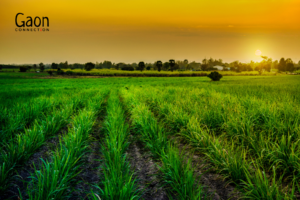With rising annual temperatures affecting crop yields of cereals like wheat, agricultural scientists at the Indian Institute of Wheat and Barley Research (IIWBR) are researching the development of wheat varieties that are resistant to heat.
Heat stress causes a significant damage to the yield as well as the quality of wheat produced and rising temperatures owing to global warming is a threat to the cereal which is the staple for more than one-third of the population across the world.
Ratan Tiwary, chief scientist at Karnal (Haryana) based told Gaon Connection that their research is based on cultivating samples of wheat varieties at two different time intervals —one at the early onset of the Rabi season and the other towards the end of it.
Also Read: A zero tillage seed drill assures farmers of better yield and more savings
“The varieties that are sown towards the end have to face higher temperatures before being harvested and are more resistant to heat. We focus on these varieties and observe the average temperature of day and night. If the average temperature exceeds 20 degrees celsius, the crop faces damage by fifteen to thirty per cent,” Tiwary said.
“We are developing heat resistant varieties by enhancing these existing varieties which are sown towards the end of the sowing season,” he added.
Heat shocks used to make wheat heat resistant
After identifying the varieties that have a better chance of survival in hotter conditions, the scientists use a technique which is based on growing the wheat plants at different temperatures.
“We have constructed small poly-house-like structures in which we grow different types of wheat. As soon as wheat grain begins to form in the plants, we cover the structure which results in a sudden increase in the internal heat. This is done to simulate the conditions of heat waves. A sudden jump by almost five degrees celsius prepares the plant to adapt to such loo-like conditions,” the scientist explained.
The temperature-control mechanism is a computerised set up. It is learnt that the sensors installed inside the polyhouse record the vital details of the wheat plant. Also, when the temperature needs to be lowered, the air-conditioning system releases water from sprinklers which gradually cools down the entire polyhouse.
Irrigation, winds and day-night temperatures
The scientist informed Gaon Connection that apart from temperature itself, the duration of hot days are significant.
“Usually, the wheat plant sustains high temperatures for three continuous days but if the temperature is more than the normal temperature by twenty degrees for more than three days, damage gets hard to avoid,” Tiwary told Gaon Connection.
The agriculture scientist also underlined the importance of day and night temperatures and their effect on the wheat crop. The scientist informed that if the night temperature decreases significantly due to winds, the wheat crop gets some time to recuperate from the day’s heat.
“Irrigation is important too. Areas that have irrigation facilities. Farmers irrigate their fields in the evening which has a cooling effect on the plants,” he said.
The scientists from the Karnal-based institute have earlier developed wheat varieties that are not only disease-resistant but somewhat resistant to heat as well. These varieties include DBW 187 (Karan-Vandana) and DBW 387 (Karan Vaishnavi) whose production is upto 8,000 kilogrammes per hectare.



















